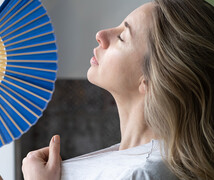A drop in estrogen levels often associated with menopause and other conditions can cause uncomfortable and sometimes painful dryness and thinning of the vaginal walls. When estrogen creams and other topical therapies aren’t effective, the Mona Lisa Touch® laser is a noninvasive treatment option that can offer relief for vaginal dryness and other symptoms related to menopause.
According to Susann Clifford, MD, an obstetrician/gynecologist who offers this treatment at Duke Women's Health Associates at Patterson Place in Durham, “This nonhormonal, noninvasive intervention goes a long way to restore vaginal tissue to premenopausal levels. We're stimulating the body to heal itself." Here, Dr. Clifford covers some of the common questions women ask about laser treatment for vaginal dryness.
Who Is a Candidate?
The nonsurgical treatment is ideal for perimenopausal and post-menopausal women, as well as for women with breast cancer who experience vaginal dryness following chemotherapy or hormone therapy, which can affect estrogen production.
When Is Vaginal Dryness Laser Treatment Recommended?
Gynecologists may recommend the Mona Lisa Touch, which is a fractional CO2 laser, when other treatment options haven't helped. Common menopause therapies may start with over-the-counter lubricants and also include estrogen therapy. Vaginal dryness laser treatment is ideal for women who are unable to receive or unsuccessful in receiving hormonal treatment.
What Is the Mona Lisa Touch® Laser Treatment Process?
A series of three to four laser sessions is required. The sessions, which are scheduled about six weeks apart, use an FDA-approved technology and take about five minutes to complete.
Women are positioned as they would be for a pelvic exam and may need some topical numbing cream. During the procedure, Dr. Clifford uses the laser inside and outside the vagina, to make tiny scratches on the vaginal wall. This stimulates the growth of new blood vessels and improves the production of elastin and collagen to restore vaginal walls.
"...this nonhormonal, noninvasive intervention goes a long way to restore vaginal tissue to premenopausal levels. We're stimulating the body to heal itself."


What Are the Side Effects?
Most women feel general soreness or discomfort after the procedure but are able to move on their own immediately after treatment. Women can resume normal activities within two days, although they should avoid sexual activity for five-to-seven days.
Is Mona Lisa Touch Covered by Insurance?
The Mona Lisa Touch is not covered by health insurance, but you may be able to use flexible spending account (FSA) or health savings account (HSA) funds to cover the costs.
The cost is $1,800 total for the initial series of vaginal dryness treatment sessions. Women are counseled to return every 12-to-18 months for additional treatments, which cost $500 each.
Is This Laser Treatment Done for Cosmetic Reasons?
While the Mona Lisa Touch laser is an effective way to offer relief from vaginal dryness and other symptoms related to low estrogen levels, it is not a cosmetic procedure, nor is it meant to act as “vaginal rejuvenation.”
“This procedure is not meant to tighten the vagina or give it a more ‘youthful appearance,’” Clifford said. “But by restoring vaginal health, and reducing pain and discomfort of vaginal dryness, a natural by-product can be improved intimacy and relations.”
Susann Clifford, MD, is an obstetrician and gynecologist at Duke.




